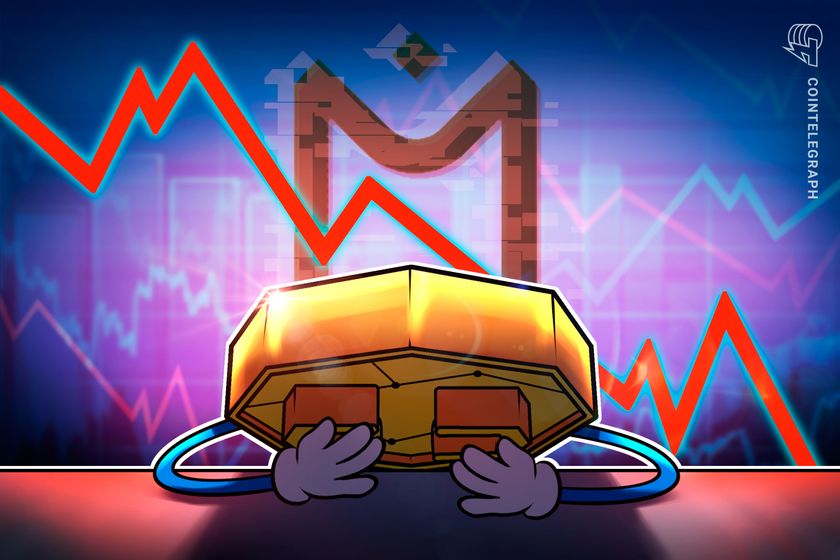Índice de miedo y codicia
Top 7 ganadores
| Criptomoneda | Cambio en 24 horas |
|---|---|
 Hyperliquid (hype) Hyperliquid (hype) | 7.77% |
 Render (render) Render (render) | 6.52% |
 Solana (sol) Solana (sol) | 5.96% |
 Binance Staked SOL (bnsol) Binance Staked SOL (bnsol) | 5.76% |
 Bitcoin Cash (bch) Bitcoin Cash (bch) | 4.03% |
 Quant (qnt) Quant (qnt) | 3.98% |
 Polkadot (dot) Polkadot (dot) | 3.09% |
Top 7 perdedores
| Criptomoneda | Cambio en 24 horas |
|---|---|
 Curve DAO (crv) Curve DAO (crv) | -4.54% |
 Official Trump (trump) Official Trump (trump) | -3.81% |
 KuCoin (kcs) KuCoin (kcs) | -3.38% |
| -2.96% | |
 OKB (okb) OKB (okb) | -2.48% |
 TRON (trx) TRON (trx) | -2.36% |
| -1.46% |


Bybit is shutting down more of its Web3 services after axing its non-fungible token (NFT) marketplace earlier in April.
According to an April 16 announcement, the exchange is shutting down its Cloud Wallet (a hosted custodial wallet), Keyless Wallet (non‑custodial multiparty computation wallet with no seed phrase), NFT marketplace, multi‑chain decentralized exchange (DEX) DEX Pro and the Swap & Bridge cross‑chain swap widget on May 31.
On April 28, 2025, Bybit will also discontinue Web3 Points, its internal loyalty program that rewarded onchain activity with redeemable points for fee discounts, airdrop boosts and early-bird perks.
On the same day, the exchange will shut down its inscription marketplace, the decentralized NFT marketplace NFT Pro, the gateway to the Apex Pro derivatives DEX, its fiat-to-crypto on-ramp, and its initial DEX offering service.
Related: Bybit recovers market share to 7% after $1.4B hack
A strategic pivot
Bybit announced its intention to shut down its NFT marketplace earlier this month. The decision follows a similar decision by major NFT marketplace X2Y2.
Still, the firm is not just cutting products from its line. Recent reports indicate that Bybit has integrated the Bitcoin (BTC) yield product of lending protocol Avalon to offer Bitcoin yield to its users. Avalon said it will allow the platform’s users to earn yield from Bitcoin by arbitrating on its fixed-rate institutional borrowing layer.
Related: BitMEX CEO explains how perpetual swaps test altcoin value
Bybit refocusing its efforts
Bybit said it is shutting down the services in order to focus on the quality of its core products. The announcement reads:
“In line with our commitment to the evolving onchain ecosystem and delivering high-quality services to our Web3 users, we will be optimizing our current Web3 product and service offerings.“
These apparent cost-cutting efforts by the company follow Bybit’s loss of about $1.4 billion in a major hack in February.
“Bybit is Solvent even if this hack loss is not recovered, all of the client’s assets are 1 to 1 backed — we can cover the loss.“
According to some rumors, the exchange may be looking to recoup the loss in other ways as well. Bybit has denied claims that it charges $1.4 million to list a token on its platform, following allegations made by a social media user.
Bybit had not responded to Cointelegraph’s request for comment by publication.
Magazine: Your AI' digital twin’ can take meetings and comfort your loved ones


Fartcoin (FARTCOIN), a Solana-based memecoin launched in October 2024, has soared over 370% from its yearly low, outperforming Bitcoin (BTC) even as global trade tensions weigh on broader risk assets.
These are the five key reasons why FARTCOIN is soaring faster than top cryptocurrencies.
PEPE boom similarities fuel FARTCOIN hype
FARTCOIN's recent surge mirrors the early stages of Pepe’s (PEPE) meteoric rise.
In 2023, PEPE launched with a rapid ascent to a $1.8 billion market cap before crashing down to $255 million, according to the PEPE/WETH weekly chart.
From there, it bottomed out, consolidated, and then entered a second, even more powerful rally that carried it beyond a $4 billion valuation.
The euphoric pump, harsh correction, and quiet accumulation phase look similar to what FARTCOIN is showing now.
The Solana memecoin peaked near $2.4 billion earlier this year before undergoing a brutal drawdown. Its valuation dropped to around $365 million, forming a rounded bottom pattern.
From there, FARTCOIN has steadily climbed back, reaching around $949 million as of this week. That is strikingly similar to PEPE’s post-hype accumulation phase in 2023.
“I genuinely think there's a chance Fartcoin repeats the PEPE playbook and pulls some crazy multiples from here,” wrote market analyst MacroCRG, citing the PEPE memecoin fractal.
Fartcoin’s social media hype spikes 500%
FARTCOIN appears to be riding a fresh wave of speculative mania, with social media metrics revealing a sharp rise in online activity.
FARTCOIN’s social volume (orange line) surged by nearly 500% in early April, preceding its 100%-plus gains in the month, according to data resource LunarCrush.
As of April 17, the engagement had cooled slightly, albeit remaining elevated at 177% above baseline.
Social dominance (purple) and social contributors (blue) have both trended higher, up 161.69% and 136.07%, respectively.
Rising social media activity in crypto markets often correlates with increased speculative interest, particularly in meme-driven assets.
While not a guaranteed indicator of future price action, a surge in social metrics can reflect growing community engagement and heightened visibility—factors that are now coinciding with sharp moves in FARTCOIN.
Fartcoin OI jumps over 500%
Fartcoin’s open interest (OI) in the futures market has jumped by around 504% so far in 2025, according to data resource CoinGlass. A rising OI indicates a massive influx of capital and attention from traders.
In contrast, Bitcoin’s OI has declined by 10.5% during the same period, reflecting reduced speculative interest in the leading crypto asset.
Adding to the bullish case, FARTCOIN's funding rates have remained largely positive throughout April, showing that more traders are betting on the price going up than down.
Periods of negative funding rates in the FARTCOIN futures market have consistently aligned with disproportionately large short liquidations, highlighting the risks of betting against this popular memecoin.
A clear example occurred on April 9, when FARTCOIN’s eight-hour funding rate plunged to -0.023%, signaling a wave of bearish sentiment as traders aggressively shorted the token.
But in a classic short squeeze, FARTCOIN surged by nearly 50% within the same day, triggering $9.16 million in short liquidations, compared to just $2.52 million in longs.
This stark imbalance underscores a growing pattern: when too many traders lean bearish, FARTCOIN often moves sharply against them.
As a result, short sellers appear to be treading carefully, as excessive pessimism has repeatedly backfired, turning negative funding into a setup for explosive upside moves.
Fartcoin is founder-less
Fartcoin’s rise reflects more than just meme-fueled hype—it stems from a unique narrative that actively blends AI innovation with internet absurdity.
New Zealand-based AI researcher Andy Ayrey created an AI agent called the Terminal of Truth, which conceived Fartcoin as part of an experiment in merging artificial intelligence with blockchain humor.
This unusual origin story has caught the attention of traders looking to capitalize on the intersection of AI and crypto, positioning Fartcoin as more than just a typical memecoin.
“Unlike most AI plays, it lives free of the execution risks and technical complexity of infra tokens *and* free of the fatigue and noise around tokenized agents,” wrote analyst Ben in December 2024, adding:
“This simplicity coupled with absurdity is the perfect recipe for reflexivity: higher price = higher absurdity = higher attention = higher price.”
Fartcoin’s team continues to build its brand around viral internet culture, planning a Goatse-inspired film to further fuel engagement.
It pushes the absurdity even further by incorporating a digital fart sound into its “Gas Fee” system—turning transaction costs into a deliberately crude punchline that reinforces its meme-first identity.
In doing so, Fartcoin has leveraged novelty and narrative to attract speculative capital without relying on a roadmap, founder figure, or utility.
This strategy possibly explains why it has continued to gain momentum while many other tokens stall.
Fartcoin price technicals hint at 100% gains next
FARTCOIN’s price rally also has strong technical backing.
The 4-hour chart of FARTCOIN/USDT shows an inverse head-and-shoulders pattern, a classic bullish reversal signal that often marks the end of a downtrend and the beginning of a sustained upward move.
This formation includes a left shoulder formed in early February, a deeper head in mid-March, and a right shoulder in early April, all anchored around a horizontal neckline around $0.63.
The pattern confirmed its breakout on April 10 when FARTCOIN surged above the neckline with strong volume. Following the breakout, the price has held above key moving averages—the 50-EMA and 200-EMA—while consolidating just under the $0.90 level.
Based on the distance from the head to the neckline, the measured move projection points to an upside target near $1.96, up by over 100% compared to current price levels.
This breakout adds a layer of technical confirmation to the ongoing rally, supporting the view that FARTCOIN’s momentum is narrative-driven and structurally supported by bullish chart patterns.
This article does not contain investment advice or recommendations. Every investment and trading move involves risk, and readers should conduct their own research when making a decision.


North Korean hackers linked to the $1.4 billion Bybit exploit are reportedly targeting crypto developers using fake recruitment tests infected with malware.
Cybersecurity outlet The Hacker News reported that crypto developers have received coding assignments from malicious actors posing as recruiters. The coding challenges have reportedly been used to deliver malware to unsuspecting developers.
Malicious actors approach crypto developers on LinkedIn and tell them about fraudulent career opportunities. Once they convince the developer, the hackers send a malicious document containing the details of a coding challenge on GitHub. If opened, the file installs stealer malware capable of compromising the victim’s system.
The scam is reportedly run by a North Korean hacking group known as Slow Pisces, also referred to as Jade Sleet, Pukchong, TraderTraitor and UNC4899.
Cybersecurity professionals warn of fraudulent job offers
Hakan Unal, senior security operations center lead at security firm Cyvers, told Cointelegraph that the hackers often want to steal developer credentials and access codes. He said these actors often look for cloud configurations, SSH keys, iCloud Keychain, system and app metadata, and wallet access.
Luis Lubeck, service project manager at security firm Hacken, told Cointelegraph that these hackers also try to access API keys or production infrastructure.
Lubeck said that the main platform used by these malicious actors is LinkedIn. However, the Hacken team observed hackers using freelance marketplaces like Upwork and Fiverr as well.
“Threat actors pose as clients or hiring managers offering well-paid contracts or tests, particularly in the DeFi or security space, which feels credible to devs,” Lubeck added.
Hayato Shigekawa, principal solutions architect at Chainalysis, told Cointelegraph that the hackers often create “credible-looking” employee profiles on professional networking websites and match them with resumes that reflect their fake positions.
They make all this effort to ultimately gain access to the Web3 company that employs their targeted developer. “After gaining access to the company, the hackers identify vulnerabilities, which ultimately can lead to exploits,” Shigekawa added.
Related: Ethical hacker intercepts $2.6M in Morpho Labs exploit
Be wary of unsolicited developer gigs
Hacken’s onchain security researcher Yehor Rudytsia noted that attackers are becoming more creative, imitating bad traders to clean funds and utilizing psychological and technical attack vectors to exploit security gaps.
“This makes developer education and operational hygiene just as important as code audits or smart contract protections,” Rudytsia told Cointelegraph.
Unal told Cointelegraph that some of the best practices developers can do to avoid falling victim to such attacks include using virtual machines and sandboxes for testing, verifying job offers independently, and not running code from strangers.
The security professional added that crypto developers must avoid installing unverified packages and use good endpoint protection.
Meanwhile, Lubeck recommended reaching out to official channels to verify recruiter identities. He also recommended avoiding storing secrets in plain text format.
“Be extra cautious with ‘too-good-to-be-true’ gigs, especially unsolicited ones,” Lubeck added.
Magazine: Your AI ‘digital twin’ can take meetings and comfort your loved ones


Mantra’s recent token collapse highlights an issue within the crypto industry of fluctuating weekend liquidity levels creating additional downside volatility, which may have exacerbated the token’s crash.
The Mantra (OM) token’s price collapsed by over 90% on Sunday, April 13, from roughly $6.30 to below $0.50, triggering market manipulation allegations among disillusioned investors, Cointelegraph reported.
While blockchain analysts are still piecing together the reasons behind the OM collapse, the event highlights some crucial issues for the crypto industry, according to Gracy Chen, CEO of the cryptocurrency exchange Bitget.
“The OM token crash exposed several critical issues that we are seeing not just in OM, but also as an industry,” Chen said during Cointelegraph’s Chainreaction daily X show, adding:
“When it’s a token that’s too concentrated, the wealth concentration and the very opaque governance, together with sudden exchange inflows and outflows, [...] combined with the forced liquidation during very low liquidity hours in our industry, created the big drop off.”
🎙️ CEXs hit with outages as AWS runs into trouble. The question is, do we need more decentralization?
— Cointelegraph (@Cointelegraph) April 15, 2025
Today, @RKBaggs and @ZVardai are joined by @GracyBitget, CEO of @Bitgetglobal on #CHAINREACTION to unpack the problem!https://t.co/OPoyu1IORC
Related: Google to enforce MiCA rules for crypto ads in Europe starting April 23
At least two wallets linked to Mantra investor Laser Digital were among 17 wallets that moved a combined 43.6 million OM tokens — worth about $227 million at the time — to exchanges before the crash, the blockchain analytics platform Lookonchain reported on April 13, citing Arkham Intelligence data.
However, Mantra CEO John Mullin denied the allegations related to large-scale token transfers from Mantra investors, Cointelegraph reported on April 14.
Mantra released a post-crash statement on April 16, reiterating that the OM crash didn’t involve token sales by the project itself and that the Mantra team continues investigating the incident. The report did not explain the rapid movement of OM tokens to exchanges and subsequent liquidations.
Related: UFC boss Dana White becomes VeChain adviser to push blockchain mainstream
Exchange movements point to strong “insider dumping” signal
While the exact reason behind the collapse remains unclear, Mullin attributed the crash to “massive forced liquidations” on centralized exchanges during low-liquidity hours on Sunday.
Mullin told an X user that the Mantra team believes one exchange “in particular” is to blame, but said the team was still “figuring out the details,” and specified that the exchange in question is not Binance.
“I think OKX was the main exchange being accused of so-called liquidations,” said Chen, adding that the large transfers to multiple exchanges raised significant red flags. She added:
“I did look at the onchain data, which revealed that there were millions of OM tokens moved to centralized exchanges. That’s a very strong signal of insider dumping.”
Weekend liquidity issues have impacted even major cryptocurrencies like Bitcoin (BTC).
The lack of weekend trading volume, combined with Bitcoin’s 24/7 liquidity, resulted in Bitcoin’s correction below $75,000 on Sunday, April 6, Cointelegraph reported.
The April 6 correction may have occurred due to Bitcoin being the only large tradable asset over the weekend available for de-risking amid global trade war concerns, Lucas Outumuro, head of research at crypto intelligence platform IntoTheBlock, told Cointelegraph.
Magazine: Illegal arcade disguised as … a fake Bitcoin mine? Soldier scams in China: Asia Express


As Polygon lays the groundwork for mainstream Web3 adoption in India by bringing blockchain access to over 450 million Reliance Jio users, it remains focused on balancing speed, scalability and affordability, without compromising on decentralization.
Polygon is working with Jio, a telecom giant owned by India’s richest man, Mukesh Ambani, to find ways to infuse blockchain technology into its existing services. The duo is currently adding blockchain-based capabilities to the JioSphere web browser, which would have been expensive, cumbersome and time-consuming via traditional methods.
“We’re building at an insane pace, onboarding massive partners, and pushing blockchain into the mainstream — but with that growth comes the responsibility to make sure we’re doing it the right way,” said Polygon’s co-founder, Sandeep Nailwal, while discussing Polygon’s India-focused initiatives with Cointelegraph.
Preserving decentralization while ensuring system scalability
“Scalability and decentralization don’t have to be either-or — and that’s exactly the balance we’re focused on at Polygon,” Nailwal said as he underscored the importance of keeping the core values of blockchain intact: security, transparency and decentralization.
At the same time, Nailwal revealed that Polygon is investing heavily in zero-knowledge technology to make scaling more seamless across the ecosystem. “The goal is to give developers and users the best of both worlds: faster, cheaper transactions without compromising trust or decentralization,” he added.
As a result of delivering the combination of low fees, fast transactions and decentralized security, Polygon is already powering some of the most active use cases in Web3 — from stablecoin payments on Polygon PoS to real-world tokenization with major institutions:
“The key challenge is making blockchain as seamless and accessible as Web2 without compromising what makes it special. That’s why we’re all-in on ZK technology and Agglayer, which let us scale while keeping the ecosystem trustless and interoperable.”
Bringing blockchain tech to millions of users
According to Nailwal, a one-size-fits-all approach does not work when onboarding 450 million users belonging to a diverse population in India. “We’ll be working closely with Jio to develop use cases that truly resonate with their users, and gradually onboard them onto the chain based on these real-world applications,” he added.
Nailwal said that developers never have to compromise on the fundamentals as Polygon’s infrastructure can scale without sacrificing what makes blockchain powerful in the first place:
“What excites me most is that we're moving beyond technical discussions about blockchain to solving real problems for real people. These are the use cases that will drive the next wave of adoption.”
“At the end of the day, it’s about more than just technology. We’re here to create a decentralized future that billions of people can actually use. And while that’s a massive challenge, it’s also what excites me the most,” Nailwal said.
Related: Indian town adopts Avalanche blockchain for tamper-proof land records
Real-world problem solving will drive the next wave of adoption
Rising threats driven by artificial intelligence tools, such as deepfakes and other misinformation campaigns, are another use case blockchain technology can help solve. Nailwal said that the escalating threat of misinformation and growing consumer insistence on trusted sources will eventually result in an uptick of blockchain-based verification tools across media houses.
Additionally, Nailwal highlighted the growing relevance of Polymarket, a cryptocurrency-based prediction market, in mainstream finance and reporting. “Polymarket’s success is exactly what we’ve been working toward,” he said, adding:
“Prediction markets are proving to be incredibly valuable tools for finance, risk assessment, journalism and even governance. They pull in insights from a wide range of sources, often making them more reliable than traditional polling.”
Nailwal is placing his full bet on blockchain’s immutable nature to transform economic forecasting, policy-making and journalism, among others.
Magazine: Your AI ‘digital twin’ can take meetings and comfort your loved ones


Bitcoin staking protocol Babylon saw $1.26 billion in BTC unstaked from its platform, reducing the protocol’s total value locked by 32%.
On April 17, blockchain analytics firm Lookonchain flagged several addresses that had unstaked a total of 14,929 Bitcoin (BTC) from the staking platform. The security firm flagged four addresses that had unstaked 299 BTC, 499 BTC, 1,000 BTC and 13,129 BTC.
One address held a majority of the unstaked assets worth $1.1 billion. With BTC prices hovering at around $84,400, the total unstaked BTC was worth about $1.26 billion.
The unstaking event saw Babylon’s total value locked (TVL) drop by 32%. According to data tracker DefiLlama, Babylon’s TVL declined from $3.97 billion to $2.68 billion after the unstaking.
Unstaked Bitcoin may be “staked back” to Babylon
Community members are speculating on who was behind the unstaking. One X user suspected that the Bitcoin may belong to the Chinese government, while another said the move may simply be a rotation, risk-off, or a trader getting liquid.
While it’s unclear who’s behind the four addresses cited by Lookonchain, the fund movements could be related to a transition initiated by the decentralized finance (DeFi) protocol Lombard Finance.
At the time of the unstaking, Babylon Labs retweeted an announcement from Lombard, saying it was unstaking Bitcoin as part of a transition to a new set of finality providers.
Lombard Finance said it timed the unstaking with the end of Babylon’s phase 1 cap 1 on April 24 so users would not miss out on rewards. The protocol said it would stake the assets back.
“All of this BTC will be staked back into Babylon as soon as the unbonding is complete,” Lombard Finance wrote.
Cointelegraph reached out to Babylon Labs for comments but did not get a response by publication.
Related: Bitcoin L2 ’honeymoon phase’ is over, most projects will fail — Muneeb Ali
Bitcoin unstaking follows BABY airdrop
The massive unstaking event follows a Babylon airdrop for early adopters. On April 3, Babylon announced the details of its early adopters airdrop program. The airdrop was allocated for its Phase 1 stakers, non-fungible token (NFT) holders and developers. The protocol allocated 600 million BABY tokens for the airdrop event.
Following the airdrop, $21 million in BTC was unstaked from the protocol. Bitlayer co-founder Kevin He previously told Cointelegraph that this was a common short-term market behavior representing early redemption.
Babylon is one of the largest Bitcoin DeFi players in the space, with a TVL reaching over $6 billion in December. Babylon co-founder Fisher Yu previously told Cointelegraph that the platform allows staking to be a native use case for Bitcoin, eliminating the need to trust another party while staking.
Magazine: Your AI ‘digital twin’ can take meetings and comfort your loved ones


Cryptocurrency exchange Binance is involved in discussions on establishing strategic digital asset reserves with several countries, its CEO, Richard Teng, reportedly said.
Binance has been advising multiple governments on establishing strategic Bitcoin (BTC) reserves and formulating crypto asset regulations, Teng said in an interview with the Financial Times on April 17.
“We have actually received quite a number of approaches by a few governments and sovereign wealth funds on the establishment of their own crypto reserves,” Teng told the FT.
Teng did not identify any countries but said that the United States is “way ahead on that front.”
US fuels global crypto reserve spree
According to Teng, the main reason for governments approaching Binance for help in handling potential strategic reserves is the new crypto-friendly agenda in the US.
Teng referred to key US crypto policy developments, such as discussions around creating a national Bitcoin reserve and digital asset stockpile. Earlier this year, Trump signed an executive order to establish a Strategic Bitcoin Reserve seeded with BTC forfeited in federal criminal and civil cases.
While governments of Pakistan and Kyrgyzstan have announced collaboration with Binance and former CEO Changpeng Zhao on crypto regulations in the past few weeks, none of the jurisdictions mentioned crypto reserve plans on their agenda.
Binance shifts stance on headquarters
As Binance deepens its involvement in efforts to help countries set up crypto reserves and regulations, it appears to have shifted away from its no-formal-headquarters approach under Zhao.
According to Teng, Binance is “working very hard” on plans for a global headquarters for the exchange.
Related: Crypto Biz: Ripple’s ‘defining moment,’ Binance’s ongoing purge
“It requires serious deliberation and the board and the senior management are spending a lot of time doing the evaluation,” Teng reportedly said, adding: “Hopefully we are able to announce our intentions on that front.”
In 2019, Zhao said that offices and headquarters are “old concepts like SMS and MMS.”
The shift comes as more jurisdictions adopt clearer frameworks for regulating crypto businesses. Binance was subject to heavy scrutiny and investigations by multiple governments in 2020.
Cointelegraph approached Binance for comment regarding its crypto policy collaboration with governments worldwide, but had not received a response by the time of publication.
Magazine: How crypto laws are changing across the world in 2025
Transacciones importantes
| Criptomoneda | Remitente | Receptor | Cantidad (USD) | Cuando |
|---|---|---|---|---|
| Unknown | Unknown | $1992889.1 | 1 minuto hace | |
| Binance | Binance | $2947481 | 1 minuto hace | |
| Unknown | Unknown | $1487351.2 | 2 minutos hace | |
| Unknown | Unknown | $1983134 | 2 minutos hace | |
| Unknown | Unknown | $1488914.9 | 3 minutos hace | |
| Unknown | Kraken | $1134981.2 | 3 minutos hace | |
| Unknown | Unknown | $1985352.2 | 3 minutos hace | |
| Unknown | Unknown | $1985352.2 | 3 minutos hace |
Eventos económicos importantes de hoy
| Hora | Evento | País |
|---|---|---|
| 22:30:00 | El número de puras puras posiciones especulativas en EUR de CFTC | Eurozona |
| 22:30:00 | El número de posiciones especulativas puras en JPY de CFTC | Japón |
| 22:30:00 | El número de posiciones especulativas puras en el BRL por CFTC | Brasil |
| 22:30:00 | El número de posiciones especulativas puras en AUD de CFTC | Australia |
| 22:30:00 | El número de puras puras posiciones especulativas por S & P 500 por CFTC | Estados Unidos |
| 22:30:00 | El número de posiciones especulativas puras en Nasdaq 100 por CFTC | Estados Unidos |
| 22:30:00 | El número de posiciones especulativas puras en oro de CFTC | Estados Unidos |
| 22:30:00 | El número de posiciones especulativas puras en el aceite crudo de CFTC | Estados Unidos |
| 22:30:00 | El número de posiciones especulativas puras en GBP por CFTC | Gran Bretaña |
| 18:00:00 | Discurso de un miembro de FOMC Dali | Estados Unidos |
| 07:00:00 | PIB | Malasia |